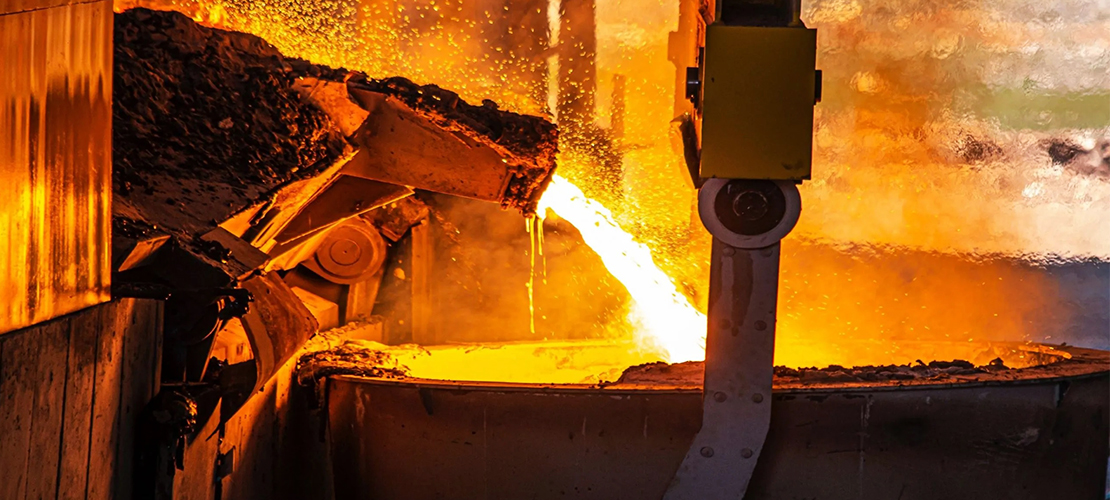Jun. 13, 2025

Difference between blast furnace and electric arc furnace the energy source and raw materials. EAF melting furnaces use electricity to generate an arc through graphite electrodes and are usually used for the smelting of scrap steel. They are smaller, more efficient, and do not require coke. Its temperature management is easier to control than that of a blast furnaces. BF furnaces, on the other hand, usually use coke as fuel to convert iron ore into pig iron. The smelting temperature of steelmaking electric furnaces can reach over 3000℃.
Blast furnace is large vertical structures that use coke, iron ore and limestone to produce molten iron through a chemical reduction process. Blast furnaces are energy-intensive equipment and are mainly used in large-scale steel production. On the other hand, electric furnaces use electric arcs to melt scrap steel or direct reduced iron (DRI), making them more flexible and environmentally friendly. Electric arc furnaces are usually used for smaller-scale production and are able to effectively recycle scrap metal.
Both BF and EAF are used in steel production, but they are very different in terms of operation, energy, and application.
Blast furnaces are large vertical structures that use coke, iron ore and limestone to produce molten iron through a chemical reduction process. It is an energy-intensive equipmen t mainly used for large-scale steel production.
The steelmaking electric arc furnaces uses electric arc to melt scrap steel or direct reduced iron (DRI), so it is more flexible and environmentally friendly. Electric arc furnace usually used for smaller-scale production and can effectively recycle scrap metals. The choice between the two depends on factors such as production scale, raw material supply and environmental considerations.
BF melting furnaces is the core of long-process steelmaking, that is, iron ore is smelted into pig iron through a blast furnace, and then refined through a converter to finally obtain qualified molten steel.
Reduction: BF puts raw materials such as iron ore into a blast furnace together with fuels such as coke, and reduces the iron oxide in the iron ore to metallic iron through a high-temperature reducing agent (usually coke).
Melting: The reduced metallic iron is melted with slag at high temperature to form pig iron.
Refining: Pig iron is refined in a converter or refining furnace to remove impurities, adjust the composition, and finally obtain qualified molten steel.
Electric arc furnace smelting belongs to short-process steelmaking, using scrap steel as the main raw material, melting the scrap steel at high temperature through electric arc, and finally producing molten steel.
Melting: Scrap steel and other raw materials are melted by electric arc heating generated by the graphite electrode of EAF.
Refining: During the melting process or in the subsequent refining furnace, alloys and other substances are added to adjust the composition, degassing, and removing impurities, and finally qualified molten steel is obtained.
Projects | Blast Furnaces | Electric Arc Furnaces (EAF) |
Operation | Continuous process for producing hot metal using coke, iron ore and limestone | Batch process using electric arc to melt scrap or DRI |
Energy | Mainly coke (fossil fuel dependent) | Electricity (renewable energy) |
Raw Materials | Iron ore, coke and limestone | Scrap, DRI and other recyclable materials |
Scale & Application | Large-scale production; poor adaptability to changes | Suitable for large and small scale production; highly flexible |
Environmental Impact | High CO2 and pollutant emissions | Reduced carbon footprint, especially with renewable energy |
Cost & Efficiency | High capital and operating costs | Low initial cost and flexible operation |
Temperature Control | Low precision due to combustion process | More precise and produces high quality steel |
That's part of the difference between blast furnace and electric arc furnace. They are both important equipment for smelting steel. While both blast furnaces and electric steelmaking furnaces are vital to steel production, they meet different needs and scales of operation.
Blast furnaces are suitable for large-scale continuous production using raw materials, while steelmaking electric furnaces offer flexibility, environmental benefits, and the ability to efficiently recycle scrap metals. The choice between these two technologies of melting furnaces depends on a variety of factors, including production scale, raw material supply, and environmental factors.
Latest News
What are the Advantages of DC Electric Arc Furnaces?
Jun. 14, 2025
Difference Between Blast Furnace and Electric Arc Furnace
Jun. 13, 2025
Latest Products
Customized metallurgical machinery and equipment range: Electric Arc Furnace, Submerged Arc Furnace, LF Refining Furnace, Vacuum Furnace, Induction Furnace, Dust Remove System, Water Treatment Equipment, etc. Providing the most advanced equipment integration services, metallurgical equipment can be customized according to different needs of customers, and production capacity can be adjusted according to customer requirements.
Electric Arc Furnace
Submerged Arc Furnace
LF Refining Furnace
VD / VOD Vacuum Refining Furnace
Induction Furnace
Furnace Accessories
Navigation
E-mail: anna@srfurnace.com
Tel: +86 159 2955 5868
WhatsApp: +86 159 2955 5868
Add:
Room 102, Building 7A, Free Trade Xintiandi, Fengdong Avenue, Fengdong New Town, Xi'an City, Shaanxi Province
